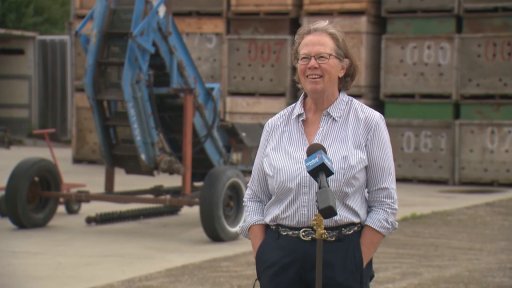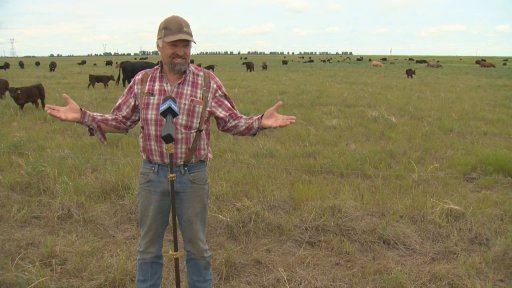High temperatures from Alberta’s heat wave, compounded by an already extremely dry season, have impacted farmers across the province.
With little rainfall in June, the streak of hot weather dried out many fields, killing some plants, and impacting the quality of others.
Read more:
High heat and low precipitation has Alberta farmers worried
Poplar Bluff Organic Farms east of Calgary depends on irrigation for their crops.
However, according to owner Rosemary Wotske, her staff just couldn’t keep up during the extreme heat.

Rosemary Wotske, owner of Poplar Bluff Organics. July 5, 2021.
Bruce Aalhus/Global News
“Even so with irrigation this spring, we would put an inch of water on and it would go to this depth and everything below would be powder. It was that dry,” she said.
“So it’s hard to get enough water on the ground to soak in, when you get a hot, dry wind right behind it, it’s gone before you know.”
The farm grows primarily root vegetables, which don’t typically thrive in high heat.
“Potatoes stop growing at 30 C, other vegetables are a little more resilient, but we are normally set up for cool-season vegetables because that’s usually what we have here. So all those cool-season things were like: what’s going on? So yeah, we didn’t have a lot of growth,” said Wotske.
Read more:
Drought outlook tool first of its kind in Canada to predict conditions 30 days in advance
According to Wotske, that disruption in the growth can decrease the quality of vegetables on the market. She says consumers may notice that come fall.
“It has impacts on yield of course, and on quality, because of plants under stress. They’ll put out chemicals to protect themselves. Often they’re bitter compounds, so the quality’s not great,” said Wotske.
According to Sandeep Nain with the Gateway Research Organization, the high temperatures caused some crops to ripen faster, reducing the quality at the end of the season.
“I’m seeing a lot of stunting in the crops — you can see the early maturity is coming in the crops due to this heat stress,” said Nain.
Nain says it’s not only vegetables that are impacted by the heat, crops such as canola have been stunted as well.
“So, all the crops are a little shortened in height and showing the symptoms of heat stress and showing the early flowering,” he said.
Cattle rancher Doug Wray says while his animals handle the heat OK, but their food source is put at risk when the high temperatures hit.
“For us to be in a situation where the pastures have almost stopped growing by the middle of June is pretty unique — it can happen in July and lots of times in August — but to have it that early in the season, you don’t have as much feed,” said Wray.

Doug Wray, owner, and co-manager of Wray Ranch. July 5, 2021.
Bruce Aalhus/Global News
In order to guarantee his hundreds of cattle are eating well, Wray put some up for auction. They were purchased by a ranch in Northern Alberta that has more feed.
Wray has made many adjustments on his ranch due to the low-moisture, including sending some cattle to land near Cochrane. However, that reduces productivity on his primary ranch, cutting into his profits.
“This ranch will send fewer pounds beef off this land base, which means… our profits will be down because of that,” said Wray.
“We’re probably going to see some increase in prices for beef.”
According to Environment and Climate Change Canada, the first week of July saw more rainfall in the Calgary area than the entire month of June, so producers are feeling relieved.
Wray said the grass on his pastures already looks greener.
“Now that we’ve had an inch of rain over the weekend and several showers we’re feeling a whole lot better. The temperature is 20 C cooler and we’ve got a little bit of moisture so that really improves the mood,” said Wray.
Read more:
Saskatchewan farmers seeding despite droughts, floods and heavy winds
According to Nain, it’s not too late for the season to improve.
“Sometimes if the situation improves and we get enough moisture and cool weather to sustain the growth, we might be able to compensate back for some of the loss,” said Nain. “Just to pinpoint how much damage we’ve seen from this heatwave, we can’t put a number yet.”
In July 2020, the Calgary area saw more than 80 mm of rainfall. As of July 6, 2021, there’s been 38.3 mm.
